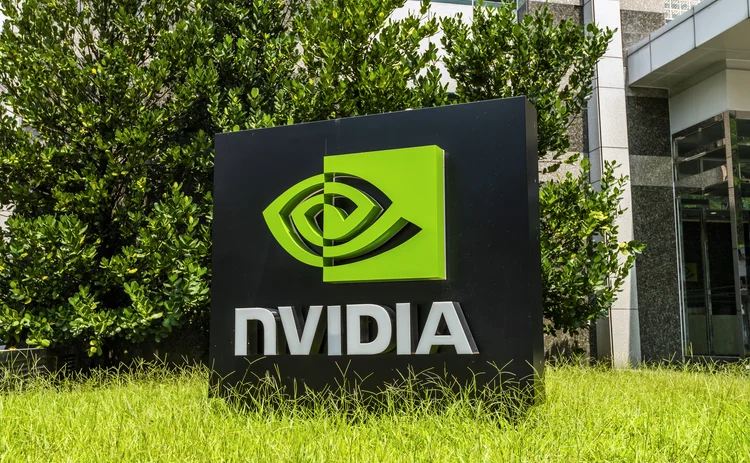
Nvidia is growing up. It’s not settling down
Nvidia is a mega cap that doesn’t act like one

Apple took three-and-a-half years to progress from a market capitalisation of $2 trillion to $3 trillion. Microsoft took just over two and a half. Nvidia made the leap in 12 weeks.
The maker of silicon chips at the centre of the hoped-for AI revolution is an exceptional case. The differences in how its stock moves, though — even compared with other tech mega caps — are worth a closer look.
In terms of how Nvidia’s stock behaves, the company is like an adult in a child’s body. And that poses challenges, particularly for investment risk managers.
From a stock market perspective, Nvidia doesn’t want to grow up
Carmine de Franco, BNP Paribas Asset Management
Apple, Microsoft and Nvidia each account individually for more than 6% of the S&P 500 index. It’s a role you could say Apple and Microsoft have grown into. As their scale swelled, daily excess returns declined. Bad days, meanwhile, became less bad.
This makes sense. Mega-cap stocks are widely held, including by less-spook-able institutional buyers. The biggest companies ordinarily have established and settled businesses with stable prospects.
The same does not entirely hold with Nvidia. “From a stock market perspective, Nvidia doesn’t want to grow up,” says Carmine de Franco, head of quant equity portfolio development at BNP Paribas Asset Management.
De Franco has run some numbers that underscore the exceptionalism. “As companies mature and make it to top spots in the index, one may expect their daily excess return would somehow be dampened in both directions,” he writes in an analysis shared with Risk.net.
Excess daily returns for Apple and Microsoft from their listings to today have been negatively correlated to their weight in the index. For Nvidia, by contrast, the correlation falls beneath the bar of statistical significance. The company has grown up but, so far, has not settled down.
De Franco looked at the three tech firms’ biggest daily losses. For Apple and Microsoft daily losses have shrunk as the companies have grown bigger. Nvidia’s, by contrast, seem to have stayed more or less unchanged.
Nvidia’s worst 5% of bad days since it grew to be 6% of the index have seen losses twice the level of Apple and Microsoft at the same point of scale.
Meanwhile, Nvidia’s stock seems unlikely to stabilise. When the company announced quarterly earnings last week, consensus-beating revenues – double last year’s – failed to lift Nvidia’s shares, which were down 7% on Friday
Recent experience shows how much this can mean. In the two months from mid-June to August 7, Nvidia lost almost a trillion dollars in market value. That’s half the entire value of the German stock exchange, de Franco notes.
All this arguably has a bearing also on the kind of market fragility that investors endured at the start of August.
Nvidia functions as the bellwether of the broader tech trade.
And the size of its market capitalisation, too, facilitates the build-up of crowded positioning, says the head of equity risk at another asset manager.
“A billion-dollar company could have high volatility but there’s a limit to who can own it. When a company is worth $3 trillion, a lot of money can move behind that.”
Options markets were implying a low double-digit percentage move in Nvidia stock ahead of earnings. Multiplied by market capitalisation, that suggests a $300 billion loss in value, he points out.
For risk managers, earnings from Nvidia and other mega-cap tech companies such as TSMC are now almost as important as a Fed rates decision or US economic data releases, the risk manager and peers report.
The Federal Reserve and the US economy, though, may be expected to throw up fewer surprises.
As BNP’s de Franco puts it: Nvidia is a company now more than 30 years old that looks at the unfolding of the AI revolution from a position of strength and is one of the biggest members of the S&P 500 Index.
“It is not yet behaving as its mega-cap status would imply.”
Only users who have a paid subscription or are part of a corporate subscription are able to print or copy content.
To access these options, along with all other subscription benefits, please contact info@risk.net or view our subscription options here: http://subscriptions.risk.net/subscribe
You are currently unable to print this content. Please contact info@risk.net to find out more.
You are currently unable to copy this content. Please contact info@risk.net to find out more.
Copyright Infopro Digital Limited. All rights reserved.
As outlined in our terms and conditions, https://www.infopro-digital.com/terms-and-conditions/subscriptions/ (point 2.4), printing is limited to a single copy.
If you would like to purchase additional rights please email info@risk.net
Copyright Infopro Digital Limited. All rights reserved.
You may share this content using our article tools. As outlined in our terms and conditions, https://www.infopro-digital.com/terms-and-conditions/subscriptions/ (clause 2.4), an Authorised User may only make one copy of the materials for their own personal use. You must also comply with the restrictions in clause 2.5.
If you would like to purchase additional rights please email info@risk.net
More on Our take
FX forwards dealers face added challenges in P&L analysis
Mark-out tools for forwards and swaps trading may not be a panacea
Can history resolve factor investors’ p-hacking questions?
Quants seek reassurance in the far distant past
Insurance double-hatters like Apollo can expect more scrutiny
Regulators are homing in on conflicts of interests at private-equity-owned insurers
Podcast: Lorenzo Ravagli on why the skew is for the many
JP Morgan quant proposes a unified framework for trading the volatility skew premium
Quants see promise in DeBerta’s untangled reading
Improved language models are able to grasp context better
Counterparty risk model links defaults to portfolio values
Fed’s Michael Pykhtin proposes using copula models to capture effects of margin calls on default risk
Does Basel’s internal loss multiplier add up?
As US agencies mull capital reforms, one regulator questions past losses as an indicator of future op risk
Is JSCC-CFTC stalemate about to be broken?
Japan CCP gains allies in battle to clear yen swaps for US clients, but CFTC shakeup could dash hopes








